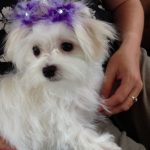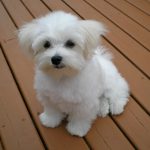 People have been enjoying the company of Maltese dogs for thousands of years, the origin of this lively toy breed being dated between 6,000 BC and 8,000 BC and credited to the Central Mediterranean area. The Maltese is thought to be bred from Spitz-type dogs and was selectively bred for a smaller size and long, soft fur. Official kennel clubs began recognizing this breed in 1898 and gave it its name in honor of the Island of Malta where many believed the breed originated. Recent years have brought on the creation of the Teacup Maltese, bred to be smaller than the original Maltese.
People have been enjoying the company of Maltese dogs for thousands of years, the origin of this lively toy breed being dated between 6,000 BC and 8,000 BC and credited to the Central Mediterranean area. The Maltese is thought to be bred from Spitz-type dogs and was selectively bred for a smaller size and long, soft fur. Official kennel clubs began recognizing this breed in 1898 and gave it its name in honor of the Island of Malta where many believed the breed originated. Recent years have brought on the creation of the Teacup Maltese, bred to be smaller than the original Maltese.
Appearance and Grooming
The Teacup Maltese comes in one solid color which should be a stark, clean white. Their fur is ideally free of markings, and their fur should be long and silky. While the Maltese should weigh in between 4 and 6 pounds, the Teacup Maltese is bred to be smaller, weighing between 2 and 4 pounds. These teacup dogs stand between 8 and 10 inches tall when measured at the shoulders. The breed earns its name because the puppies can easily fit inside a teacup, and some even remain small enough to fit as adults.
A moderately high amount of grooming is required to maintain the smooth and silky appearance of this teacup breed. If cared for daily, the fur is easier to maintain and stays healthy and clean. A fine-toothed comb is helpful when grooming teacup dogs as they typically have finer and more delicate fur. The fur must be thoroughly brushed before bathing or it will become knotted very quickly and may require shaving if allowed to tangle.
Health and Longevity
The Teacup Maltese is at a higher risk of developing a variety of medical ailments that larger dogs may not be as susceptible to. Toy breeds, in general, are at risk of developing knee and spine problems, and teacup breeds are known for having more fragile bones and a delicate structure. Other common medical problems that owners of this breed may see are dental disease, hypoglycemia, seizures and heart problems.
The Teacup Maltese has a shorter lifespan than the original Maltese, and some from breeders whose lines have poorer health may only live a few years. Seeking a puppy from a breeder who focuses on health and whose lines have long lifespans is the first step to selecting a teacup dog. Puppies born from healthy lines are less likely to die young and are not as prone to known health issues as puppies from unknown lineage.
Regular examinations by a veterinarian are important in maintaining the health of teacup dogs. As educated professionals, veterinarians and their staff will often be able to notice the signs of health problems before owners and work to treat them before resulting in more permanent damage. All dogs should be seen by a veterinarian once per year, but many professionals recommend having teacup dogs seen at least twice annually due to the high risk of medical issues.
Other ways to ensure prolonged health for a teacup dog include feeding them a healthy diet and providing them with the appropriate level of exercise for their age and size. Exercising a Maltese is not only necessary for maintaining good physical health but also to stimulate the mind. This will make training easier as they can focus better when not trying to contain copious amounts of energy.
Behavior and Training
As a highly energetic breed, these dogs can require some effort to train but will be eager to please and easy to work with. Both treats and praise are appropriate rewards for training a Maltese puppy of any size, but it is important to always ensure that the treats being used are small enough for the puppy to eat quickly but not to choke on. Soft treats are ideal for training teacup puppies because of their small teeth.
Many toy breeds are known for jumping and barking excessively, so it is important to train a Maltese away from these behaviors early. Due to their small size, owners often do not allow them to truly act like dogs. It is possible to be cautious while also allowing teacup dogs to explore their environment and interact with other dogs so that they can be properly socialized.
A Small but Sweet Pup
The Maltese is a fun companion breed, and teacup puppies from quality breeders can make fantastic pets for owners seeking a small and friendly dog. Though they can be at risk of developing a number of health problems, many breeders focus on improving the overall health of the breed. As the classic teacup breed, the Maltese is perfect.








